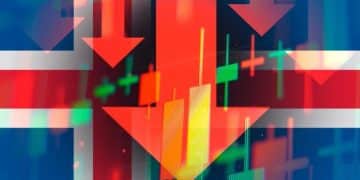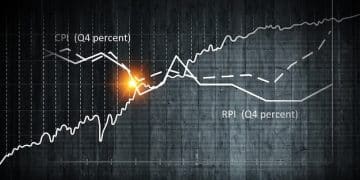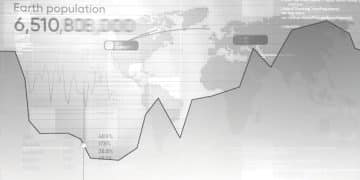Fed Rate Hike 2025: Expert Predictions & Analysis
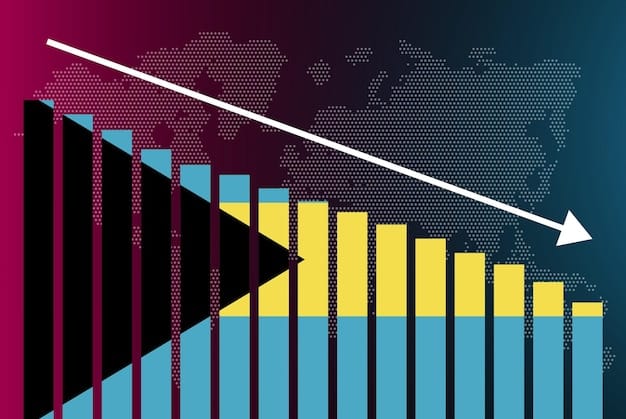
The prospect of the Federal Reserve raising interest rates again in early 2025 is a complex issue influenced by inflation, labor market dynamics, and global economic stability, requiring ongoing analysis from economists and policymakers to forecast its likelihood and impact on financial markets.
The question, will the Fed raise interest rates again in early 2025? looms large for investors, businesses, and everyday consumers. Navigating the murky waters of economic forecasting requires a nuanced understanding of current trends, historical precedents, and the Federal Reserve’s evolving policy objectives. This article delves into expert analyses and various predictions to shed light on this crucial financial query.
The Federal Reserve’s Dual Mandate and Policy Tools
Understanding the Federal Reserve’s actions begins with its dual mandate: to foster maximum employment and maintain price stability. These two objectives often present a delicate balancing act, as measures to curb inflation can sometimes temper job growth, and vice versa. The primary tool for achieving these goals is the federal funds rate.
The federal funds rate serves as a benchmark for interest rates across the economy. When the Fed raises this rate, it typically makes borrowing more expensive for banks, which then translates to higher interest rates for consumers and businesses on loans, mortgages, and credit cards. Conversely, lowering the rate makes borrowing cheaper, stimulating economic activity. The effectiveness of these tools depends heavily on the prevailing economic conditions and public confidence.
Historical Context of Fed Rate Decisions
Looking back, the Fed’s history is replete with cycles of tightening and easing monetary policy. Periods of high inflation, such as the late 1970s and early 1980s, saw aggressive rate hikes. Conversely, economic downturns, like the 2008 financial crisis or the COVID-19 pandemic, prompted significant rate cuts and quantitative easing measures. Each period offers lessons, but rarely a perfect blueprint for future actions, given the unique confluence of factors at play.
Consider the recent inflationary surge following the pandemic. Supply chain disruptions, robust consumer demand fueled by fiscal stimulus, and geopolitical events all contributed to price pressures. The Fed responded with a series of aggressive rate hikes, aiming to cool the economy and bring inflation back towards its 2% target. The speed and magnitude of these hikes were notable, marking a significant shift from the prolonged period of near-zero rates that preceded it.
- Inflation Targeting: The Fed aims for a 2% average inflation rate over the long run, considering it ideal for sustainable economic growth.
- Employment Data: Key indicators such as unemployment rates, wage growth, and labor force participation influence the Fed’s assessment of maximum employment.
- Economic Activity: GDP growth, consumer spending, and business investment provide a broader picture of economic health.
The cumulative effect of these past rate adjustments is still unfolding. While inflation has shown signs of moderation, the path back to the 2% target is not linear. Simultaneously, the labor market has remained surprisingly resilient. The interplay between these forces will continue to shape the Fed’s decisions as 2024 progresses and 2025 approaches.
In essence, the Fed’s role is akin to a finely tuned instrument, constantly adjusting its settings based on vast amounts of incoming economic data. It’s not about making snap judgments but rather a considered, data-driven approach, always mindful of the long-term health and stability of the U.S. economy.
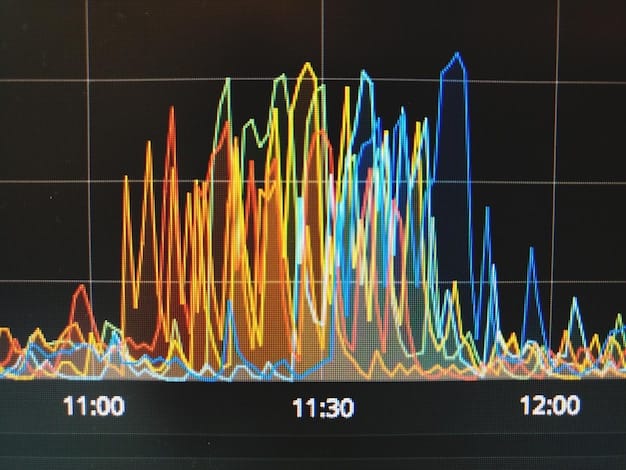
Key Economic Indicators Influencing the Fed’s Decision
The Federal Reserve’s policy decisions are fundamentally data-dependent. Several critical economic indicators capture the Fed’s attention, as they provide a snapshot of the economy’s health and inflationary pressures. Understanding these metrics is crucial to anticipating whether the Fed will consider another rate hike in early 2025.
First and foremost is inflation. The Consumer Price Index (CPI) and the Personal Consumption Expenditures (PCE) price index are closely watched. The PCE, particularly its core measure (excluding volatile food and energy prices), is the Fed’s preferred gauge of inflation. A persistent deviation above the Fed’s 2% target would certainly strengthen the case for further tightening, while a sustained deceleration toward the target could alleviate pressure for hikes.
The Crucial Role of the Labor Market
Employment data is another cornerstone of Fed analysis. The unemployment rate, non-farm payrolls, and average hourly earnings reveal the strength and tightness of the labor market. A robust labor market, especially one characterized by strong wage growth, can fuel inflationary pressures as higher wages lead to increased consumer spending. Conversely, signs of softening in the labor market might signal economic weakness and reduce the urgency for rate hikes.
Current trends show a labor market that has, remarkably, withstood the impact of previous rate hikes. Unemployment remains low, and job creation, while slowing, continues to be positive. However, policymakers are also looking for signs of a rebalancing, where labor supply meets demand more closely, potentially easing wage pressures without a significant increase in unemployment.
- Inflation Data: Monthly and annual changes in CPI and PCE, with a focus on core PCE, are paramount.
- Labor Market Health: Unemployment rate, job growth, wage inflation, and labor force participation rates.
- Economic Growth: Gross Domestic Product (GDP) reports indicate the overall pace of economic expansion or contraction.
Beyond these, consumer spending, often measured by retail sales, provides insight into aggregate demand. Strong consumer spending can indicate economic vitality but also contribute to inflation if supply cannot keep pace. Business investment, housing market activity, and global economic conditions also play a role, influencing the Fed’s comprehensive outlook. The state of international trade, geopolitical stability, and the performance of major global economies can impact U.S. inflation and growth trajectories, indirectly influencing Fed policy.
The Fed also closely monitors financial conditions, including stock market performance, bond yields, and the availability of credit. Tighter financial conditions (e.g., higher borrowing costs, lower asset prices) can themselves act as a brake on the economy, potentially reducing the need for direct Fed intervention. The interplay of these diverse indicators creates a complex mosaic that informs every policy decision, making forecasting a challenging, though essential, endeavor.
Expert Analysis: Arguments For and Against a Rate Hike
The economic landscape is rarely uniform, and expert opinions on future interest rate movements reflect this complexity. As early 2025 approaches, economists are weighing various factors, leading to strong arguments both for and against another Fed rate hike.
Arguments for a Rate Hike:
A key argument for further rate increases centers on persistent inflation. While headline inflation measures may have moderated from their peak, core inflation, which strips out volatile food and energy prices, could remain stubbornly elevated. If supply chain issues persist, or if strong consumer demand continues to push prices up, the Fed might feel compelled to act to ensure inflation sustainably returns to its 2% target.
Another factor is the potential for a resilient labor market to continue driving wage growth. If wage increases outpace productivity gains, they can contribute to a wage-price spiral, making it harder to bring inflation down. In such a scenario, the Fed might decide that a minor increase is necessary to cool demand and prevent the economy from overheating. Furthermore, some experts argue that global inflationary pressures, stemming from geopolitical events or commodity price surges, could necessitate a domestic response from the Fed to maintain purchasing power.
Counterarguments: Why the Fed Might Hold Steady or Cut Rates
Arguments against a Rate Hike:
Conversely, a significant body of opinion suggests the Fed may hold rates steady or even consider cuts by early 2025. The primary reason is the cumulative effect of past monetary tightening. Interest rate changes operate with a lag, and the full impact of previous hikes may not yet be fully realized. As these effects ripple through the economy, they could lead to a more significant slowdown or even a mild recession, obviating the need for further tightening.
Concerns about economic growth are also paramount. If leading indicators suggest a slowing economy, such as weakening consumer confidence, declining manufacturing output, or rising unemployment, the Fed might prioritize supporting growth over further inflation containment. Moreover, if inflation continues its downward trend and gets closer to the 2% target without further intervention, the Fed would have less incentive to raise rates, preferring to observe the impact of existing policy.
- Sticky Inflation: If core inflation remains elevated, prompting the Fed to act more.
- Resilient Labor Market: Continued strong wage growth and low unemployment could fuel more demand.
- Global Economic Shocks: Unforeseen events impacting supply chains or commodity prices.
Finally, global economic instability and financial market vulnerabilities could deter the Fed from raising rates. If other major economies face significant challenges, or if there are signs of stress in the financial system, the Fed might choose to avoid actions that could exacerbate these issues. The balancing act is complex, and the optimal path forward remains a subject of intense debate among
economists, policymakers, and market participants. Each piece of incoming data will be scrutinized, potentially shifting the consensus view.
The Impact of Geopolitical Events and Global Economics
While the Federal Reserve primarily focuses on domestic economic conditions, the U.S. economy does not operate in a vacuum. Geopolitical events and the broader global economic landscape can significantly influence the Fed’s decisions regarding interest rates. These external factors can impact inflation, economic growth, and financial stability, indirectly shaping monetary policy.
One of the most direct influences is through commodity prices. Major geopolitical events, such as conflicts or supply chain disruptions in key producing regions, can lead to spikes in oil, gas, and food prices. Since these commodities are fundamental inputs across many industries, their price fluctuations directly affect inflation in the U.S. A sustained surge in global energy prices, for instance, could reignite inflationary pressures domestically, making a rate hike more likely, even if internal demand is moderating.
Trade Relations and Global Supply Chains
Global trade relations and the resilience of international supply chains also play a crucial role. Tensions between major trading blocs, tariffs, or disruptions to shipping routes can lead to higher import costs, translating into elevated consumer prices. The experience of the COVID-19 pandemic highlighted the vulnerability of global supply chains and their capacity to generate inflationary pressures. Policymakers are now more attuned to these risks, and any significant re-acceleration of global supply chain issues could influence the Fed’s stance.
- Energy Prices: Geopolitical tensions impacting oil and gas supply.
- Global Growth: Slowdowns in major economies affecting U.S. exports and corporate earnings.
- Exchange Rates: A strong dollar can curb inflation by making imports cheaper, while a weak dollar has the opposite effect.
Furthermore, the economic performance of other major economies, particularly China and Europe, can have ripple effects on the U.S. A slowdown in global growth could dampen demand for American exports, impact corporate earnings, and potentially weigh on the U.S. labor market. Conversely, strong global growth could exert upward pressure on commodity prices and contribute to inflation. The interconnectedness of global financial markets also means that significant crises or instability abroad could spill over into the U.S., potentially requiring a nuanced response from the Fed to maintain stability.
Lastly, the exchange rate of the U.S. dollar against other major currencies is another consideration. A stronger dollar makes imports cheaper and can help curb domestic inflation, while a weaker dollar has the opposite effect. Global capital flows, driven by interest rate differentials and risk perceptions, can influence the dollar’s value. The Fed takes these international dynamics into account, understanding that “America First” in economic policy doesn’t mean “America Alone” when it comes to the complex forces shaping inflation and growth.
Market Expectations vs. Fed Projections
A fascinating aspect of monetary policy forecasting is the occasional divergence between market expectations and the Federal Reserve’s own projections. While the Fed aims for transparency, interpreting its signals and anticipating its next move is an art as much as a science for market participants. This dynamic creates volatility and opportunities in financial markets.
The Federal Reserve communicates its outlook primarily through the Summary of Economic Projections (SEP), often called the “dot plot.” This provides individual Fed officials’ forecasts for inflation, unemployment, GDP growth, and the federal funds rate over the next few years. The median of these dots gives a sense of the Fed’s collective thinking. However, these are projections, not guarantees, and individual opinions can shift.
How Markets Interpret Fed Signals
Financial markets, particularly bond markets, spend considerable effort trying to anticipate the Fed. Futures contracts on the federal funds rate provide a real-time gauge of market expectations for future rate changes. When these market expectations diverge significantly from the Fed’s dot plot, it signals a difference in outlook on the economy or the appropriate policy response.
For instance, markets might anticipate rate cuts sooner than the Fed projects, reflecting a belief that inflation will fall faster or that a recession is more likely. Conversely, if inflation proves stickier than expected, markets might price in additional hikes that the Fed’s current dot plot does not yet indicate. This gap then becomes a critical point of analysis, as either the Fed must adjust its communication or the market will eventually align with the Fed’s direction, often through price adjustments.
Transparency is a double-edged sword for the Fed. While it aims to provide clear guidance, too much certainty can inadvertently influence market behavior in ways that complicate policy implementation. The Fed prefers to remain “data-dependent,” signaling flexibility rather than a rigid commitment to a specific path. This adaptability is critical given the uncertain nature of economic forecasting, but it also necessitates careful market interpretation.
Market reactions to Fed announcements are often immediate and significant. A hawkish tone (suggesting higher rates) can strengthen the dollar and lead to lower stock prices, while a dovish tone (suggesting lower rates) can have the opposite effect. The balance between market expectations and Fed projections often drives short-term market movements and influences investor strategies as early 2025 draws near. Understanding this interplay is key to navigating the potential shifts in the financial landscape.
Potential Scenarios for Early 2025
Forecasting the Federal Reserve’s actions for early 2025 involves considering a range of potential scenarios, each driven by different assumptions about how economic conditions will evolve. No single outcome is guaranteed, and the Fed’s data-dependent approach means it will react to the reality on the ground.
Scenario 1: Further Rate Hike (Low Probability, but Possible)
This scenario occurs if inflation proves to be more persistent than currently anticipated, potentially due to renewed supply chain disruptions, a resurgence in commodity prices, or a surprisingly robust and inflationary labor market that continues to push wages significantly higher. If the Fed’s preferred inflation gauges (like core PCE) show signs of reaccelerating or stubbornly remaining above 2.5%, the central bank might determine that additional tightening is necessary to achieve its price stability mandate. This outcome would likely surprise markets and could lead to renewed volatility in equities and a strengthening dollar.
Scenario 2: Rates Remain on Hold (Most Likely Scenario)
Many economists currently lean towards the Fed holding rates steady through early 2025. This outcome assumes that inflation continues its gradual decline towards the 2% target, albeit perhaps slowly. The labor market might show signs of rebalancing, with job openings decreasing and wage growth moderating, without a sharp rise in unemployment. In this scenario, the Fed would likely adopt a “wait and see” approach, assessing the full impact of past rate hikes and taking comfort in the disinflationary trend. This would provide a period of stability for businesses and consumers, allowing them to adjust to the current interest rate environment.
Scenario 3: Rate Cuts Begin (Moderate Probability)
A third scenario involves the Fed beginning to cut interest rates in early 2025. This would primarily be driven by clear signs of economic weakness, such as a significant slowdown in GDP growth, a notable increase in the unemployment rate, or a faster-than-expected decline in inflation. If the economy enters a mild recession, or if financial market stability becomes a concern, the Fed would likely pivot to an easing stance to support growth and employment. Such a move would be welcomed by borrowers and potentially boost asset markets, though it would simultaneously signal underlying economic challenges.
The path the Fed ultimately takes will be determined by the cumulative weight of incoming data over the coming months. It’s a dynamic process, and investors and businesses need to remain agile, capable of adjusting their strategies to whichever scenario ultimately unfolds. Monitoring the key economic indicators discussed earlier will be paramount in anticipating the Fed’s next move and preparing for its implications.

Implications for Investors and Consumers
Regardless of whether the Federal Reserve raises rates again in early 2025, holds them steady, or initiates cuts, the implications for investors and consumers will be significant. Understanding these potential impacts is crucial for making informed financial decisions.
For Investors:
If the Fed raises rates, bond yields would likely increase, making fixed-income investments more attractive relative to equities. However, higher borrowing costs could temper corporate earnings growth, potentially leading to downward pressure on stock prices. Growth stocks, particularly those reliant on future earnings, might be more affected, while value stocks or defensive sectors could prove more resilient. Investors might consider rebalancing portfolios towards less interest-rate sensitive assets or those with stable cash flows.
Conversely, if the Fed holds rates steady or cuts them, it could signal growing confidence in a “soft landing” or a need to stimulate a slowing economy. Lower rates generally make equities more appealing as the cost of capital decreases for companies and bond yields become less competitive. This could favor growth-oriented investments and potentially lead to a broader market rally, though the underlying reason for cuts (e.g., recession concerns) would need careful consideration.
Impact on Debt and Savings for Consumers
For Consumers:
The impact on consumers is direct and tangible. A rate hike translates to higher borrowing costs for new mortgages, auto loans, and credit card debt. Adjustable-rate mortgages would see immediate increases in monthly payments. This can squeeze household budgets and dampen big-ticket purchases. For savers, however, higher rates mean better returns on savings accounts, money market funds, and certificates of deposit (CDs).
If rates remain on hold, consumers can expect stability in their existing variable-rate debts, and the cost of new borrowing will not increase. Savings rates would also remain relatively stable. In a scenario of rate cuts, borrowers would benefit from lower interest payments on variable-rate loans and cheaper financing for new purchases. This could stimulate consumer spending, particularly in housing and durable goods. Simultaneously, savers would see their returns on deposits diminish, potentially prompting them to seek higher yields elsewhere.
- Borrowing Costs: Direct impact on mortgages, auto loans, and credit card interest rates.
- Savings Returns: Influences returns on bank accounts, money market funds, and CDs.
- Investment Returns: Affects stock valuations, bond yields, and overall portfolio performance.
The ability to adapt to changing interest rate environments is key for both investors and consumers. Reviewing personal budgets, assessing debt structures, and re-evaluating investment strategies periodically are prudent steps. Staying informed about economic indicators and Fed communications will empower individuals to make decisions that align with their financial goals, whether the Fed decides to hike, hold, or cut rates in early 2025.
| Key Point | Brief Description |
|---|---|
| 📊 Inflation Outlook | Fed’s decision hinges on core PCE inflation moving sustainably towards 2%. |
| 💼 Labor Market Health | Strength of jobs data, including wage growth, will influence policy. |
| 🌍 Global Factors | Geopolitical events and global growth can impact domestic policy. |
| 🔮 Market Sentiment | Market expectations and Fed’s guidance can diverge, causing volatility. |
Frequently Asked Questions About Fed Rate Hikes
The Federal Reserve raises interest rates primarily to combat inflation. By making borrowing more expensive, it aims to cool down economic activity, reduce demand, and ultimately bring prices back down towards its 2% target. This is part of its mandate to maintain price stability.
The Fed closely monitors several key indicators, with inflation data (especially the Personal Consumption Expenditures – PCE price index) and labor market statistics (like unemployment rates and wage growth) being the most crucial. Other factors include GDP growth, consumer spending, and global economic conditions.
For consumers, a rate hike means higher borrowing costs for new loans, such as mortgages, car loans, and credit card debt. Existing variable-rate loans would also see increased monthly payments. Conversely, savers would benefit from better returns on their savings accounts and CDs.
The Federal Reserve operates under a “dual mandate” from Congress: to achieve maximum employment and maintain price stability. This means balancing efforts to ensure as many people as possible have jobs, while also keeping inflation at a healthy, consistent level, typically around 2%.
Absolutely. Geopolitical events can significantly influence global commodity prices, supply chains, and overall economic stability. If these events lead to renewed inflationary pressures or create significant economic uncertainty, they could indirectly sway the Fed’s decision towards or away from a rate hike.
Conclusion
The prospective decision by the Federal Reserve regarding interest rates in early 2025 remains a subject of intense scrutiny, influenced by a complex interplay of domestic and global economic forces. While the path ahead is uncertain, a constant dedication to monitoring inflation, labor market dynamics, and broader economic health will guide the Fed’s approach. Investors, businesses, and individual consumers must remain vigilant, adapting to potential shifts in monetary policy to safeguard their financial well-being. Ultimately, informed decision-making, coupled with a nuanced understanding of economic signals, will be paramount in navigating the economic landscape of 2025 and beyond.


